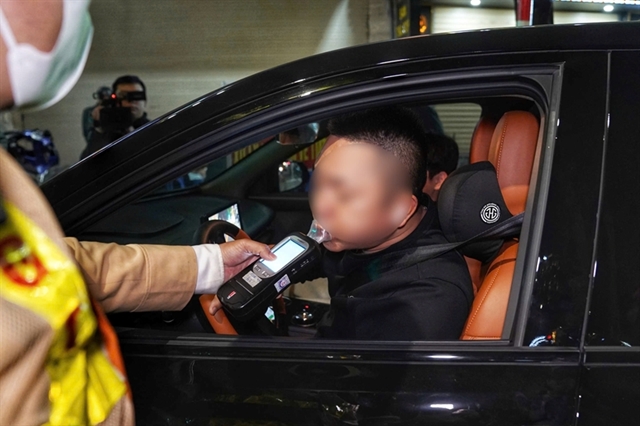 Opinion
Opinion

A doctor takes up a hefty dictionary and some thick medical textbooks. He does not open their pages to look up some obscure disease and its treatment, though.
By Thu Vân
A doctor takes up a hefty dictionary and some thick medical textbooks.
He does not open their pages to look up some obscure disease and its treatment, though.
He uses their height as a stool to hang himself.
This is not a scene from a dramatic soap opera, but an incident that happened in our country not too long ago. The doctor was hounded for a mistake he might or might not have committed. His death was not an admission of guilt, but a decision of despair at having been treated as guilty before the facts of the case were ascertained beyond doubt.
The doctor in this instance was an ophthalmologist, and his death should have opened our collective eyes to some systemic problems with our healthcare system, but that does not seem to have happened, as another physician can testify.
For doctor Hoàng Công Lương, March 18, 2018 dawned as yet another day of normal work at the intensive rehabilitation ward of the artificial kidney department at the Hoà Bình General Hospital.
And he continued to work normally even as he learnt that he would be charged with "unintentional killing” and “irresponsible behaviour causing serious consequences.”
The serious charge that the young doctor (31) is facing stems from a tragedy that occurred last May during his work shift. As many as eight patients died the same day of suspected anaphylactic shock (an extreme, often life-threatening allergic reaction to an antigen to which the body has become hypersensitive).
An official investigation concluded that the deaths were caused by excessive flouride found in the Reverse Osmosis water supply system, rendering the water unfit for use in dialysis machines. They also found that a staff member repairing the supply system negligently left chemicals behind after cleaning some membrane casings. Later, the staff also failed to test the water as required by regulations.
What was doctor Lương’s role in this mishap, then? According to the indictment, he was responsible for checking if the Reverse Osmosis (RO) water qualified for treatment. When informed by a nurse that the RO system was ready, Lương didn’t check it or report back to the department head.
The doctor was held in custody for 13 days before being released in July. Lương returned to work at the Hoà Bình Hospital. Now, nine months later, he has been slapped with serious charges.
My doctor friends have told me unequivocally that getting caught up in legal proceedings makes it virtually impossible for them to focus on their real work of treating sick people.
However, Lương was able to continue his work unfazed, because his conscience was clear. He said he was confident that he’d done his best, been responsible, and done nothing wrong, professionally or otherwise.
Many other doctors share his belief. They’ve said Lương should not be held responsible for the quality of the machines or the drugs used to treat the patients. Instead, they have argued, the police and other concerned authorities should look into the maintenance company and the hospital leaders who signed the maintenance contract.
One of them asked: “Since when do doctors have to take responsibility for the machines he’s using? And how can he check – in Lương’s case, should he taste or drink the water to make sure it’s purified?”
The indictment also said that doctor Lương had operated the dialysis machines without signing a document indicating that the water treatment company had handed over the repaired machines to the hospital, earning him the charge of “irresponsible behaviour causing serious consequences.”
Be that as it may, concerned authorities needed to ask another simple question before taking a step that would not just destroy the career of a young doctor, but also make other doctors wary of performing urgent procedures or surgeries because of anxiety over administrative procedures.
The question: Would following administrative procedures to the letter have averted the tragedy and saved the lives of the patients?
The investigators themselves had reached a conclusion that residual chemicals had caused the deaths, not the lack of a document. Meanwhile, the Ministry of Health has no official document stipulating that doctors are responsible for checking RO water quality before use.
Rush to judgement
It seems convenient that whenever something wrong happens, there is a rush to find someone or some people guilty, prescribe some punishment, and move on. In this case, such rush will serve no stakeholder, be it the patients, the doctors or the healthcare sector itself.
After the tragedy, it was found that the hospital had no standard procedure for testing RO water for medical use. While the Ministry of Health does have instructions on cleaning the dialyzer for reuse, it too does not have a standard procedure for repairing or checking the safety of RO water after the repairs are done. It is likely, therefore, that most of the hospitals in the country have no such standard procedure.
How is a doctor to blame, then?
The only document available on RO water quality management is at the Bạch Mai Hospital, one of the country’s leading hospitals in dialysis. But the document indicates clearly that this is an internal procedure that applies only to one hospital. Nothing in the Ministry of Health’s documents on dialysis suggests that this is a compulsory procedure for any other hospital in the country.
In fact, a survey of 70 hospitals nationwide by the Health and Environment Institute last September found no one had a procedure to check the quality of RO water. Clearly, this is a big loophole that is the ministry’s responsibility to fix.
A doctor who wanted to stay anonymous said many doctors who work in the dialysis units have never been trained to actually check the quality of the RO water after the machines are repaired. They depend on the water treatment company to do its work with due care and diligence.
Why is a doctor being blamed for a systemic failure, then?
It is germane at this juncture to look at the details of the case where a doctor committed suicide.
On the morning of July 16, 1996, doctor Nguyễn Duy Minh with the National Hospital of Ophthalmology gave sub- conjunctival injections of Gentamycin and Hydrocortisone to a patient. A few hours later, the patient experienced great pain in his left eye and he said he could no longer see. An emergency operation had to be performed.
The patient’s family requested the hospital and the Ministry of Health to fire doctor Minh and demanded a huge sum in compensation from him. Minh was forced to stop working. No more patients, no coaching aspiring students, no lectures at the university.
Four months later, he hung himself at home.
After his death, his younger sister revealed that he’d talked to her a lot. He advised her to study well and acquire a lot of knowledge, but also said he did not want her to become a doctor.
Is this the message we want to give our younger generations? That it is better not to become a doctor?
Doctors are not infallible, but it is incumbent on them to do their best to avoid mistakes. However, they are not sole custodians of the healthcare sector. Just as the system has a mission to treat and save people, it needs to give doctors the protection and security they need to do their job with confidence. Of course, this is not to say that mistakes and wrongdoings should be covered up.
The death of eight patients at the Hòa Bình hospital indicts the system more than it does any individual, least of all the doctor on duty. The implications of doctor Lương not receiving a fair trial and the health ministry not taking the trouble to fix big loopholes in the system are far more serious.
It is the health of the healthcare system that is at stake. — VNS




